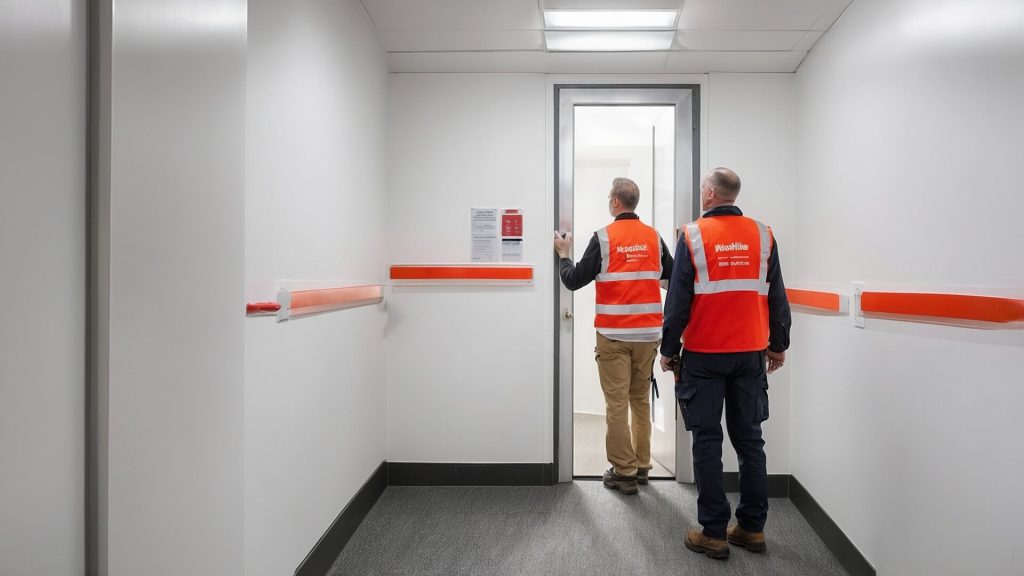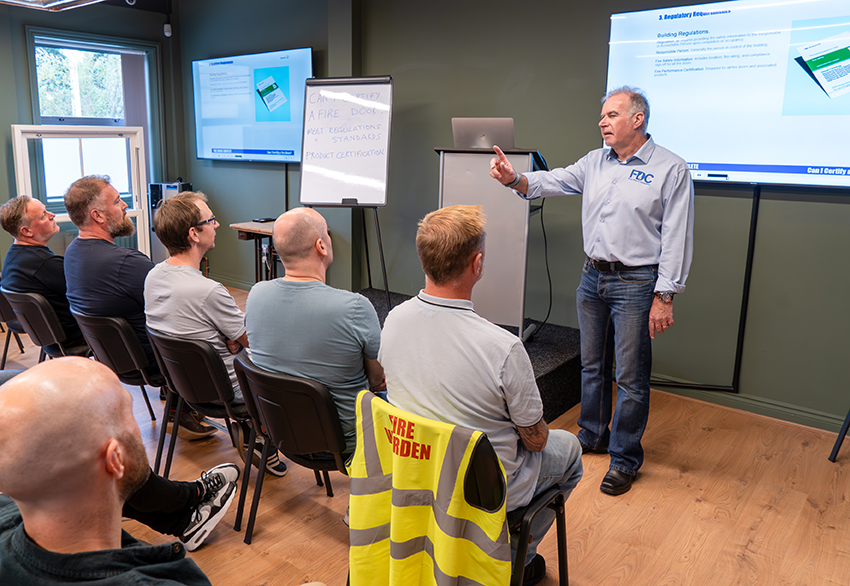Fire doors are an essential component of a building’s passive fire protection system. They play a critical role in compartmentalising buildings, preventing the spread of fire and smoke, and protecting escape routes in the event of a fire. Unlike standard doors, fire doors are specially designed and tested to withstand fire for specific periods – typically providing between 30 to 60 minutes of protection depending on their rating.
In residential buildings, commercial properties, and especially in communal areas of blocks of flats, properly functioning fire doors can mean the difference between life and death. They form part of a building’s fire safety measures and are a legal requirement in many locations.
But how do you know if your fire doors are up to current safety standards? This is where fire door inspection comes in – a crucial aspect of maintaining fire safety within any building. Regular inspections help ensure fire doors remain in good working order and continue to provide the level of protection they’re designed for.

Who Can Legally Inspect Fire Doors in the UK?
Understanding who can inspect fire doors requires knowledge of the regulatory framework governing fire safety in the UK. The short answer is that different levels of inspection can be carried out by different people, depending on their qualifications and the type of inspection required.
The Responsible Person
Under the Regulatory Reform (Fire Safety) Order 2005, non-domestic premises and the common areas of blocks of flats (including the entrance door to individual flats) in England and Wales must have a designated ‘responsible person’ – usually the employer, landlord, or building owner. This person has legal duties to ensure fire safety throughout the premises, including the upkeep of fire doors.
The responsible person must ensure that:
- A fire risk assessment is carried out and regularly reviewed.
- Fire doors and other fire safety measures are maintained in efficient working order.
- Regular fire door inspections take place to maintain doors, either by themselves or by a competent person.
While inspection and maintenance can be delegated, the responsible person retains overall legal responsibility for compliance.
Basic Visual Checks – In-House Staff
Basic visual checks of fire doors can be carried out by in-house staff with sufficient knowledge/training. These frequent checks should identify obvious issues such as:
- Damage to the door (including glazing)
- Issues with self-closing mechanisms
- Obstructions preventing doors from closing
- Damaged or missing fire door signage
- Problems with seals or gaps around the door
These basic visual checks are not a substitute for formal fire door inspections but form part of a building’s fire safety routine. They’re particularly important during the first year of use when new doors may settle and require adjustment. Checks are mandatory at tall blocks of flats in compliance with the Fire Safety (England) Regulations 2022.
Competent Persons – Facilities Managers and Trained Staff
More thorough checks of all fire doors should be conducted by a ‘competent person’ – someone with appropriate knowledge, training, and experience. This might include:
- Facilities managers with fire door training
- Maintenance staff who have completed specific fire door courses
- Building managers with relevant qualifications
A competent person should understand building regulations (particularly Approved Document B), fire door components, and the importance of fire doors as part of a building’s means of escape.
Certified Fire Door Inspectors – Professional Specialists
For a comprehensive, professional fire door inspection, you need a certified fire door inspector. These specialists have:
- Completed accredited fire door training courses
- Deep knowledge of industry standards
- Understanding of the legal framework
- Skills to identify less obvious defects
Professional inspections are recommended in high-risk buildings or those with high traffic. These inspections are particularly important for blocks of flats, care homes, schools, hotels, and any building where occupants may sleep, are vulnerable, or where escape is not straight forward.
A thorough professional inspection will examine all aspects of a fire door. The inspector will document findings, identify non-compliances, and provide recommendations for remedial actions.

How Fire Doors Complete Can Help
At Fire Doors Complete, we provide professional fire door inspection services across multiple sectors. Our team of fully qualified inspectors have extensive experience ensuring fire door compliance in housing associations, care homes, schools, hospitals, and commercial buildings.
What makes our inspection service different:
- Our inspections are covered by ISO 9001 quality management certification
- Our inspectors are mature, experienced specialists with suitable experience and qualifications
- We have extensive knowledge of all types of fire doors
- We take a collaborative approach, helping you understand issues rather than simply condemning doors
We don’t just identify problems – we can help you create a staged plan for addressing fire door safety issues, prioritising the most critical areas first. This practical approach helps building owners manage budgets whilst still improving safety.

Ensuring Fire Door Compliance
Regular fire risk assessments that include inspections of fire doors are essential for compliance with fire safety regulations. They protect occupants, preserve property, and could even affect insurance coverage.
Whether it’s basic visual checks by trained staff or comprehensive inspections by certified professionals, every level of inspection plays a part in maintaining your building’s fire safety.
If you’re responsible for fire safety in any part of a building, make sure you understand your legal obligations regarding fire door inspection and maintenance. And if you need support with professional inspections, training, or advice on fire door compliance, Fire Doors Complete is here to help.
For more information, you can:
- Call us on 07599 425388
- Email us at robin@firedoorscomplete.com
- Use our online contact form
Frequently Asked Questions
How often should fire doors be inspected?
BS 9999 recommends six-monthly inspections and basic visual checks are a requirement of the Fire Safety (England) Regulations 2022, quarterly for doors in communal areas and annually for flat entrance doors, in blocks of flats above 11 metres in height. Fire Doors must be maintained in good condition and more detailed checks by competent persons will be very helpful in this regard. Professional inspections at high-risk and high-traffic buildings are strongly recommended and may be required more frequently.
Can I inspect my own fire doors if I’m a homeowner?
While homeowners can and should conduct basic checks to ensure fire doors aren’t damaged and close properly, formal fire door inspections require specific knowledge. If you own a property with legal fire safety obligations, such as a landlord of multiple occupancy buildings, you should engage a fire door specialist.
What qualifications should a fire door inspector have?
Professional fire door inspectors should have completed recognised fire door training courses carrying certification by awarding bodies. At Fire Doors Complete, our inspectors hold multiple industry-recognised certifications and have extensive practical experience across various sectors. We also offer recognised training programmes for inspection, installation and maintenance of timber-based fire doors.
